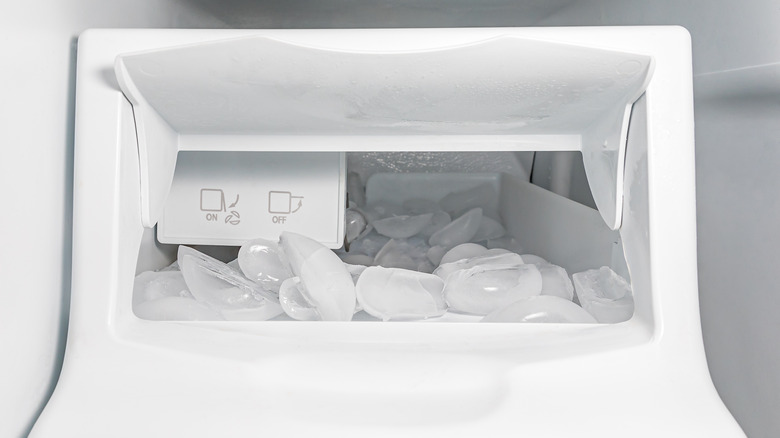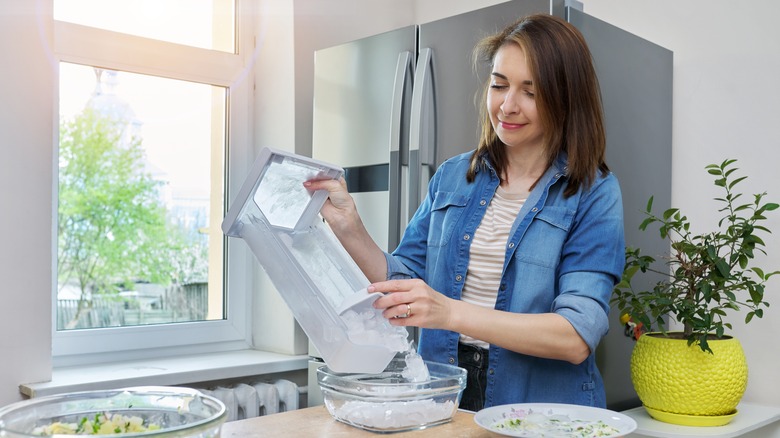Here's What Really Happens If You Never Clean Your Ice Maker
Of all of the appliances and surfaces that you clean in your kitchen, it is easy to forget about your ice maker. Whether you have a portable ice maker or use one that is built into your refrigerator, you might skip over it during routine cleaning sessions. Maybe you have never even cleaned it at all. Many homeowners do not understand the importance of this task. If you never clean your ice maker, you run the risk of consuming ice that has been contaminated with bacteria, which will make you sick.
You may assume that the low temperature of your freezer will protect your ice from bacteria growth. Unfortunately, this is not the case. There are quite a few types of bacteria that actually thrive in cold environments. They can transfer to your ice maker when people reach with bare hands to grab ice. Food in your freezer can also contaminate your ice when it comes into contact with the appliance. Bacteria and diseases like Legionnaire's Disease and E.coli may make their way inside, which poses a health risk to you and your family. With all of these potential risks, it is important to clean your ice maker with our five-step process.
Bacteria from contaminated ice can make you sick
It is a common misconception that freezing temperatures reduce or eliminate the spread of all bacteria and diseases. While bacteria growth slows in low temperatures, they remain unharmed, proliferating when reintroduced to room temperatures. This is why it is important to keep your ice maker clean. Let's dive into some of the types of bacteria that could make their way into your ice maker.
Psychrophiles not only live in cold climates but also spread. This is a type of spoilage bacteria that could be found in the food you may store in your freezer, though it is unlikely to be a threat. Listeria monocytogenes is another type of bacteria that can contaminate freezers. It has been found in frozen dairy products in the past.
If frozen food that contains listeria monocytogenes comes into contact with your ice maker, you may end up with contaminated ice. This can lead to the development of Listeriosis, which is a disease that typically causes fever, gastrointestinal problems, and muscle aches. It can even result in death in extreme cases. To avoid these diseases and bacteria, it is vital to clean your ice maker frequently and properly.
How to clean your ice maker the right way
If you have an ice maker built into your freezer, start by removing everything in it. Wipe each section of the freezer with a damp, soapy cloth. This may seem excessive, but it will help you identify any spoiled food that could spread illnesses and bacteria. Spoiled food can also emit an unpleasant odor that may make its way into your ice machine, ruining the delights of a cold beverage.
Next, unplug the appliance and wash all compartments of your ice maker according to the instructions in your user manual. The cleaning products you can use safely and the appropriate disinfecting process will vary depending on the appliance's model. Repeat this cleaning process every six months. To help you set an effective routine, consider cleaning your ice maker when you are due for a water filter replacement, which is also biannually.
Finally, plug your appliance back in and allow three cycles of ice to run through before you begin using it in beverages again. Dispose of each of those unusable batches of ice. This will help clear out any cleaning solution residue so it does not transfer to your ice. You can clean your countertop ice maker with this budget-friendly DIY solution by taking it apart and wiping out the components, ensuring you follow the guidance in its user manual.


